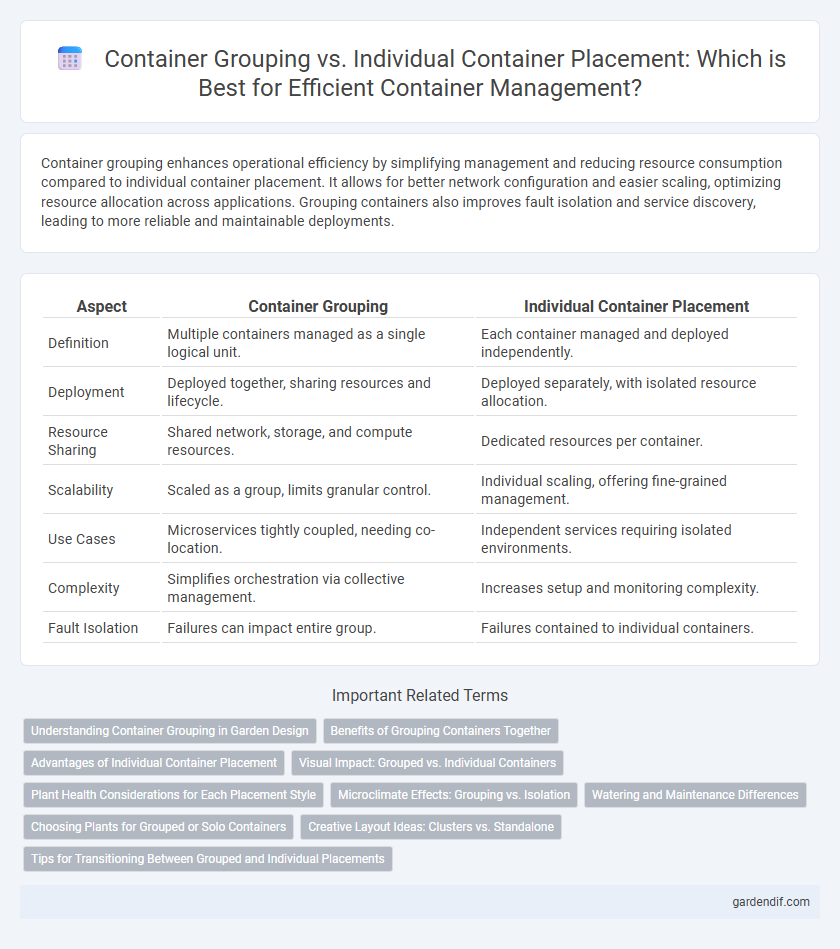
Container grouping vs individual container placement Illustration
Container grouping enhances operational efficiency by simplifying management and reducing resource consumption compared to individual container placement. It allows for better network configuration and easier scaling, optimizing resource allocation across applications. Grouping containers also improves fault isolation and service discovery, leading to more reliable and maintainable deployments.
Table of Comparison
| Aspect | Container Grouping | Individual Container Placement |
|---|---|---|
| Definition | Multiple containers managed as a single logical unit. | Each container managed and deployed independently. |
| Deployment | Deployed together, sharing resources and lifecycle. | Deployed separately, with isolated resource allocation. |
| Resource Sharing | Shared network, storage, and compute resources. | Dedicated resources per container. |
| Scalability | Scaled as a group, limits granular control. | Individual scaling, offering fine-grained management. |
| Use Cases | Microservices tightly coupled, needing co-location. | Independent services requiring isolated environments. |
| Complexity | Simplifies orchestration via collective management. | Increases setup and monitoring complexity. |
| Fault Isolation | Failures can impact entire group. | Failures contained to individual containers. |
Understanding Container Grouping in Garden Design
Container grouping in garden design enhances visual impact by creating cohesive and layered displays that mimic natural plant communities, promoting microclimate benefits such as shared moisture retention and shade. Grouped containers facilitate efficient space utilization and simplify maintenance compared to individual container placement, allowing gardeners to cluster plants with similar water, light, and soil requirements for optimal growth. This approach also encourages creative arrangements, combining various textures, colors, and heights to achieve dynamic and balanced garden aesthetics.
Benefits of Grouping Containers Together
Grouping containers together enhances space utilization by reducing gaps and optimizing stacking, thereby increasing storage efficiency in warehouses and shipping yards. It simplifies inventory management through consolidated tracking and handling, which lowers labor costs and minimizes the risk of misplaced items. Grouped containers also improve security and stability during transport by distributing weight evenly and preventing container shifting.
Advantages of Individual Container Placement
Individual container placement allows for precise allocation of resources, optimizing space utilization within a facility or ship. It enhances flexibility in loading and unloading processes, reducing handling time and minimizing the risk of damage. This method also supports tailored security measures per container, improving overall cargo safety and traceability.
Visual Impact: Grouped vs. Individual Containers
Grouping containers creates a cohesive visual impact by establishing symmetry and balance, enhancing overall aesthetics in a space. Individual container placement offers flexibility, allowing for unique focal points and personalized design expressions that can highlight specific plants or features. The choice affects spatial perception, where grouped containers unify the environment and individual placements provide dynamic variety.
Plant Health Considerations for Each Placement Style
Container grouping promotes a microclimate that can enhance humidity and reduce temperature fluctuations, benefiting moisture-sensitive plants and reducing stress on root systems. Individual container placement allows for precise control over sunlight exposure and air circulation, minimizing the risk of fungal diseases and enabling tailored nutrient management. Choosing between grouping and individual placement depends on specific plant species' health needs, balancing factors like airflow, light intensity, and humidity to optimize growth conditions.
Microclimate Effects: Grouping vs. Isolation
Grouping containers creates a distinct microclimate by increasing humidity and reducing temperature fluctuations, promoting healthier plant growth. Individual container placement exposes plants to more variable environmental conditions, which can stress sensitive species but also enhances airflow and reduces disease risk. Optimizing container arrangement based on microclimate needs is essential for maximizing plant health and growth efficiency.
Watering and Maintenance Differences
Container grouping allows synchronized watering and maintenance, ensuring uniform moisture levels and reducing water waste. Individual container placement demands tailored watering schedules to accommodate varying sun exposure and plant needs, increasing maintenance complexity. Grouped containers simplify fertilization and pest control by enabling simultaneous treatment, unlike scattered arrangements requiring separate attention.
Choosing Plants for Grouped or Solo Containers
Selecting plants for grouped containers emphasizes complementary colors, textures, and varied heights to create a cohesive visual impact, enhancing outdoor or indoor aesthetics. In contrast, individual container placement allows for focused attention on a single plant's unique characteristics, often highlighting its growth habit or striking foliage. Understanding sunlight, water requirements, and space constraints is essential for both approaches to ensure healthy plant development and design harmony.
Creative Layout Ideas: Clusters vs. Standalone
Container grouping enables creative layout ideas by forming clusters that enhance spatial organization and visual harmony through proximity-based arrangement, fostering intuitive navigation and thematic coherence. Individual container placement allows for flexible, standout positioning emphasizing unique content, creating focal points that draw attention and support diverse design aesthetics. Balancing clusters and standalone containers optimizes user experience by combining structured groupings with impactful singular elements in interface design.
Tips for Transitioning Between Grouped and Individual Placements
When transitioning between grouped and individual container placements, prioritize understanding workload requirements and network topology to optimize resource allocation and minimize latency. Use container orchestration tools like Kubernetes to manage scaling and automate placement adjustments based on real-time metrics. Monitor service dependencies and communication patterns closely to ensure seamless integration and avoid performance bottlenecks during the shift.
Container grouping vs individual container placement Infographic

 gardendif.com
gardendif.com